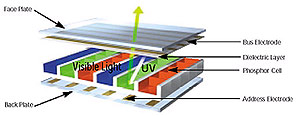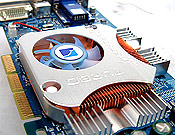|
Plasma Screens and Faster Videocards
Hello,
We're starting 2003 off with a bang! This weeks PCstats.com
newsletter is filled with a mouth watering array of speedy videocards to check out, along with a the
latest and greatest technology to hit PCstats' test labs! The best of
which is a 42" Plasma Display from Samsung that we even managed
to play a few rounds of UT2003 on... If the mere mention
of "plasma" doesn't get your heart pumping, then a review of the
latest Albatron Ti4680P-Turbo card might just do the trick. This
card uses an 8XAGP compliant Ti4200 core (note we said Ti4200,
not Ti4600) based on a Ti4600 8 layer PCB with 3.3ns
BGA DRAM!
Since
GeForce Ti4200 cards offer very good value for the budget minded gamer, we also saw
fit to end off 2002 with a roundup of four 8X AGP cards from the
likes of Abit, Albatron, MSI and Prolink. Not to be forgotten in the face
of Granite Bay motherboards is DFI's i850E-based NT72-SA RDRAM motherboard which
we benchmarked against the MSI GNB MAX.
This week, C. Angelini
talks about NV31 and ATI's R350 in the High Tech Low Down, and in addition
to dishing out Tips, Colin has a very special offer for those of you
looking for a little advice. If that new X-mas computer is driving
you nuts with noise, you may want to check out the low-noise Zalman 6500B-Cu heatsink, at our sponsor ExoticPC.
 After watching countless DVD's on good old
televisions, tiny computer screens, high-resolution LCD displays, and even
rear projection HDTV's, I can say without a doubt; once you go plasma you
never go back! Samsung's Tantus SPL4225 Plasma display measures an
impressive 42" across, and a scant three and a half inches thick. The
image quality is just luscious, and if you can forget about the nearly ten
thousand dollar (CDN) price tag (see here) for a moment, there is
virtually no downside to this display. With three similar models currently in the Tantus
plasma screen line up, it is this unit, the SPL4225, and not the 50" or
63" versions which has the best overall specs. Boasting a 16:9 aspect
ratio for optimal wide screen viewing, a 700:1 contrast ratio and 600 nits
brightness level, the SPL4225 is visually superior to an equivalently
sized rear projection HDTV when compared side by side. If that doesn't wet
your whistle, just consider the 852x480 resolution progressive scan
display bears no cooling fans to create distracting noises and the screen
specs out with 160 degree viewing angles in both axis. After watching countless DVD's on good old
televisions, tiny computer screens, high-resolution LCD displays, and even
rear projection HDTV's, I can say without a doubt; once you go plasma you
never go back! Samsung's Tantus SPL4225 Plasma display measures an
impressive 42" across, and a scant three and a half inches thick. The
image quality is just luscious, and if you can forget about the nearly ten
thousand dollar (CDN) price tag (see here) for a moment, there is
virtually no downside to this display. With three similar models currently in the Tantus
plasma screen line up, it is this unit, the SPL4225, and not the 50" or
63" versions which has the best overall specs. Boasting a 16:9 aspect
ratio for optimal wide screen viewing, a 700:1 contrast ratio and 600 nits
brightness level, the SPL4225 is visually superior to an equivalently
sized rear projection HDTV when compared side by side. If that doesn't wet
your whistle, just consider the 852x480 resolution progressive scan
display bears no cooling fans to create distracting noises and the screen
specs out with 160 degree viewing angles in both axis.
Read the
Rest...
| TechWatch How Plasma Makes
Pictures |
| |

Unlike a CRT (Cathode Ray
Tube) display which shoots electrons through a metal mask onto different
coloured pixels (red, green and blue), a plasma display uses little cells
of excited Xenon or Neon gas to create ultraviolet light. The
plasma panel is made up of an array of tiny cells which we all know
as pixels. However, each pixel contains three subpixels of phosphors corresponding
to the colours red, green and blue. Sandwiched against these cells is a thin layer
of gas in a plasma state. Electrical impulses enter the gas, which
emits bursts of ultraviolet light at precise locations, and
intervals, as determined by the digital video signal. The phosphor
cells absorb these signals and then re-radiate the energy as visible
light in varying intensities.
|
|
|
 For half of the price of
nVIDIA's high-end GeForce4 Ti46
00 videocard, you can grab yourself 90%
if its performance with a GeForce4 Ti4200 based card. There's really no argument,
the GeForce4 Ti4200 has been the best value in 2002. Albatron's original Ti4200P-Turbo
videocard took the hardware community by storm. The card combined a
Ti4400/4600 PCB and 3.3ns memory so well that many enthusiasts could
overclock it well past Ti4600 levels. We played with the Ti4200P-Turbo in September '02 and were equally
taken with its performance qualities. With nVIDIA rehashing their
Ti4200\Ti4600's to incorporate 8x AGP technology, it was only
inevitable that Albatron would redo their very successful Ti4200
Turbo's as well! For half of the price of
nVIDIA's high-end GeForce4 Ti46
00 videocard, you can grab yourself 90%
if its performance with a GeForce4 Ti4200 based card. There's really no argument,
the GeForce4 Ti4200 has been the best value in 2002. Albatron's original Ti4200P-Turbo
videocard took the hardware community by storm. The card combined a
Ti4400/4600 PCB and 3.3ns memory so well that many enthusiasts could
overclock it well past Ti4600 levels. We played with the Ti4200P-Turbo in September '02 and were equally
taken with its performance qualities. With nVIDIA rehashing their
Ti4200\Ti4600's to incorporate 8x AGP technology, it was only
inevitable that Albatron would redo their very successful Ti4200
Turbo's as well!
Read
the Rest...
|
When ATI and SiS released
videocards supporting 8X AGP technology, nVIDIA's GeForce4 line of GPU's
immediately seemed out of date somehow. Even though the nVidia-based video
cards are far from being slow performers, nVIDIA heard the call from
consumers, and did some quick work to bring the Ti4200 GPU's up to AGP 3.0
specs. AGP 3.0 specs a.k.a 8X AGP doubles
the available bandwidth between the videocard and the system from 1.06
GB/s to 2.1 GB/s. This means that during instances where there are a lot
of polygons and textures on the screen (for example), more data can sent
to the videocard to be computed. In theory, 8X AGP should translate into a
big performance increase; especially in videocard intensive tests like
3DMark and CodeCreatures.
| DFI NT72-SA i850E Motherboard
Review |
|
3DMark2001SE Tweak Guide - Part 3
nVIDIA Style |
|
 With
Intel dropping support for RDRAM and adopting dual channel DDR for
the Pentium 4, it's obvious that RDRAM will be soon be taking a less
important role in the P4 mainboard markets. Still, Rambus is not
going to go down without a fight, and today we're examining the DFI
NT72-SA. The DFI NT72-SA is
based on the i850E chipset, which is Intel's last to support
RDRAM. The NT72-SA was originally released by
DFI in May of 2002 and with the recent release of Granite Bay based
motherboards now, it sits under the spotlight once again. The goal
then, as it is now, was to produce a cost effective high performance
desktop motherboard so there aren't many overclocking options to
fiddle with. With
Intel dropping support for RDRAM and adopting dual channel DDR for
the Pentium 4, it's obvious that RDRAM will be soon be taking a less
important role in the P4 mainboard markets. Still, Rambus is not
going to go down without a fight, and today we're examining the DFI
NT72-SA. The DFI NT72-SA is
based on the i850E chipset, which is Intel's last to support
RDRAM. The NT72-SA was originally released by
DFI in May of 2002 and with the recent release of Granite Bay based
motherboards now, it sits under the spotlight once again. The goal
then, as it is now, was to produce a cost effective high performance
desktop motherboard so there aren't many overclocking options to
fiddle with.
Read
the Rest...
|
|
PCstats.com's 3DMark2001SE Tweak Guide - Part 2 was very popular
with ATI users, but I received a lot of e-mail from nVIDIA gamers on
how to tweak their videocards as well. I guess I can't/shouldn't
really neglect them since about 60% of the videocards out there use
nVIDIA GPU's. The 3DMark benchmarks
from MadOnion are quite popular and are often used to test the power
of computers, and while 3DMark may not always represent real world
3D performance, it is usually a good indicator. As
we said in the original 3DMark2001 Tweak Guide, the best feature of the
3DMark benchmarks is the ability to upload your score to the web and
compare your computer to some of the fastest rigs
in the world.
Read
the Rest... |
| Colin's Weekly Tech Tips |

By:
C. Sun |
Remove the Shortcut to... |
|
The ability to create shortcut keys for just
about anything is a neat, and useful feature of Windows. One of my
biggest pet peeve's is the shortcuts that are created always say
"Shortcut to" at the very beginning.
Luckily with a bit of registry editing we can get rid of that prefix. Go to Start, then Run, and type "regedit". From there follow this path... HKEY_CURRENT_USER - Software - Microsoft - Windows - CurrentVersion - Explorer. Once you're there find the "link" binary value. By default the value inside is 0000 0F 00 00 00, we want to change it to 0000 00 00 00 00.
Once that change is made just close your registry and from now on when you make a shortcut, it will no longer say "Shortcut to" anymore. This registry tweak works with all Windows OS's.
|
| Colin's Tips Archives | The PCStats.com Forums |
The Last
Word: Would you like
some computer help this weekend from Colin?
If you
have a question about what motherboard/videocard/processor you
really should get, or
need help with a tech
related problem, or simply want to juice up the speed of your
computer and need tips, then talk with Colin in the
PCstats.com forums
where he will be live,
answering your questions, from January 4th to 5th!
First timers can Join our forums right here.
|
 |
PCstats Issue
No.70
Circulation 193,000
The High Tech Low
Down
With Chris
Angelini |
|
2002 is now history, taking with it a year
of 3GHz processors and DirectX 9 graphics accelerators. We now have
a lot to look forward to in 2003, including Intel's
800MHz front side bus, the Athlon 64 from AMD, R350
from ATI, and GeForce FX from
NVIDIA .
But wait, wasn't GeForce FX supposed to be
NVIDIA's darling... last year? For
NVIDIA to compete with the RADEON 9700 Pro, it
should have been, but it clearly hasn't arrived yet. Now, we're
hearing that NV31 is slated to debut at CeBIT in
Hannover, Germany. The card isn't expected to go head-to-head with
ATI's flagship, but instead will compete against the popular RADEON 9500 Pro. Xbitlabs speculate that the card may include improved anti-aliasing and anisotropic filtering support, though there is no evidence to back this up quite yet. Of
course, ATI is expected to retaliate with RV350, a
value-oriented product that is reportedly being manufactured on a
0.13-micron process. There has been no word as to what the processor
will be capable of, but I'd expect it to make quick work of
ATI's current value contender, the RADEON 9000. On a related note, it seems that R350 is being manufactured on a 0.15-micron process, just like the R300-based RADEON 9700 Pro.
Comments?
|
|
PCstats Polls! |
|
This Years Poll:
What hardware do you want most in 2003?

PCstats News is updated throughout
the day right here by Colin himself. |
Submit a product for Review
Ad Enquiries |
